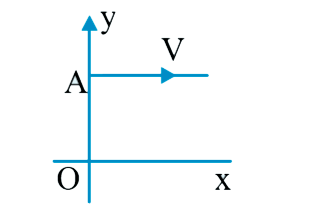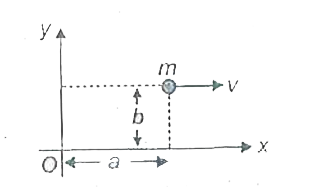Statement - 1 : A particle moves with a constant velocity parallel to the x-axis. Its angular momentum w.r.t. the origin will remains constant.
Because
Statement - 2 : Angular momentum is defined as →L=→r×→P
Statement - 1 is true, statement - 2 is true, statement - 2 is correct explanation for statement - 1
Statement - 1 is true, Statement - 2 is true, Statement - 2 is not a correct explanation for statement - 1
statement - 1 is true, statement - 2 is false
statement - 1 is false, statement - 2 is true.
The correct Answer is:A
To solve the problem, we need to analyze the two statements provided and understand the relationship between the motion of the particle and its angular momentum.
1. Understanding the Motion of the Particle:
- The particle is moving with a constant velocity parallel to the x-axis. This means that its speed and direction are not changing over time.
2. Defining Angular Momentum:
- Angular momentum (L) of a particle with respect to a point (in this case, the origin) is defined as:
→L=→r×→P
- Here, →r is the position vector from the origin to the particle, and →P is the linear momentum of the particle, which is given by →P=m→v, where m is the mass and →v is the velocity.
3. Analyzing the Angular Momentum:
- The magnitude of angular momentum can be expressed as:
L=mvrsin(θ)
- In this equation, r is the distance from the origin to the line of action of the velocity vector, and θ is the angle between →r and →v.
4. Constant Parameters:
- Since the particle is moving with constant velocity, both m (mass) and →v (velocity) are constant.
- The distance r from the origin to the line of action of the velocity vector remains constant as the particle moves parallel to the x-axis.
5. Conclusion on Angular Momentum:
- Since m, v, r, and θ remain constant throughout the motion, the angular momentum L will also remain constant. Therefore, Statement 1 is true.
6. Explanation of Statement 2:
- Statement 2 provides the definition of angular momentum, which supports the conclusion drawn in Statement 1. Thus, Statement 2 is a correct explanation for Statement 1.
Final Conclusion:
- Both statements are true, and Statement 2 is the correct explanation for Statement 1.
Answer:
- The answer is (A): Both statements are true, and Statement 2 is the correct explanation for Statement 1.
---
- The particle is moving with a constant velocity parallel to the x-axis. This means that its speed and direction are not changing over time.
- Angular momentum (L) of a particle with respect to a point (in this case, the origin) is defined as:
→L=→r×→P
- Here, →r is the position vector from the origin to the particle, and →P is the linear momentum of the particle, which is given by →P=m→v, where m is the mass and →v is the velocity.
- The magnitude of angular momentum can be expressed as:
L=mvrsin(θ)
- In this equation, r is the distance from the origin to the line of action of the velocity vector, and θ is the angle between →r and →v.
- Since the particle is moving with constant velocity, both m (mass) and →v (velocity) are constant.
- The distance r from the origin to the line of action of the velocity vector remains constant as the particle moves parallel to the x-axis.
- Since m, v, r, and θ remain constant throughout the motion, the angular momentum L will also remain constant. Therefore, Statement 1 is true.
- Statement 2 provides the definition of angular momentum, which supports the conclusion drawn in Statement 1. Thus, Statement 2 is a correct explanation for Statement 1.
- Both statements are true, and Statement 2 is the correct explanation for Statement 1.
- The answer is (A): Both statements are true, and Statement 2 is the correct explanation for Statement 1.
Similar Questions
Knowledge Check
- Question 1 - Select One
A mass M moving with a constant velocity parallel to the X-axis. Its angular momentum with respect to the origin
Aa. is zeroBb. remains constantCc. goes on increasingDd. goes on decreasing
Assertion : If a particle moves with a constant velocity, then angular momentum of this particle about any point remains constant.
Reason : Angular momentum has the units of Plank's constant.View SolutionA mass m is moving with a constant velocity along a line parallel to the x-axis, away from the origin. Its angular momentum with respect to the origin.
View SolutionA particle is moving along a straight line parallel to x-axis with constant velocity. Find angular momentum about the origin in vector form :
 View Solution
View SolutionA particle is rotating in circle with uniform speed as shown. The angular momentum of the particle w.r.t. origin is :-
 View Solution
View SolutionA solid sphere is rotating with a constant angular velocity about an axis touching the surface. Its angular momentum will be:
View SolutionA body of mass m is moving with a constant velocity along a line parallel to the x-axis, away from the origin. Calculate its angular momentum with respect to the origin?
 View Solution
View SolutionA mass is whirled in a circular path with a constant angular velocity and its angular momentum is L. If the string is now halved keeping the angular velocity same, the angular momentum is
View Solution


